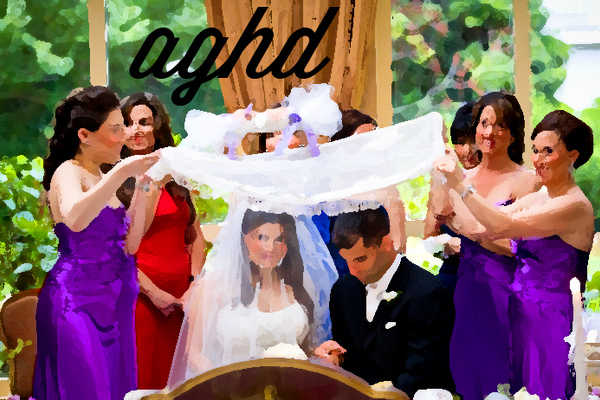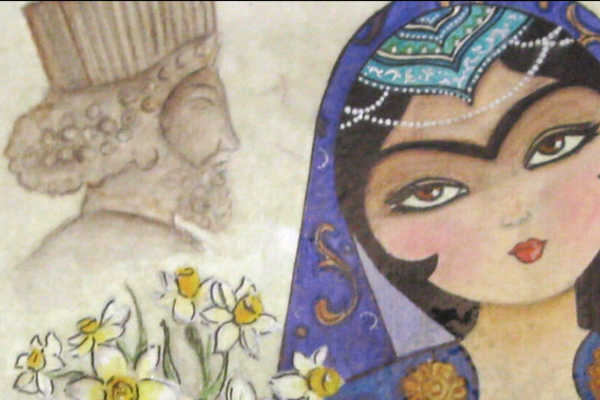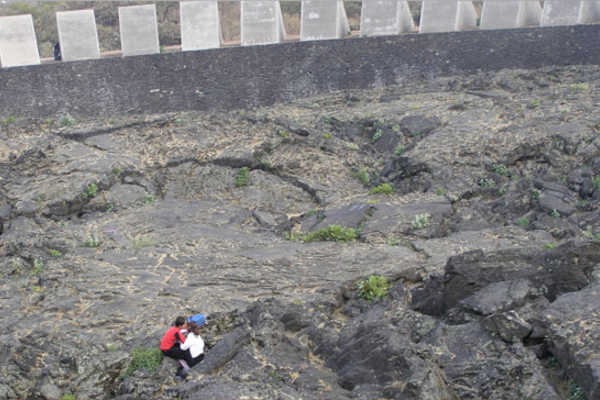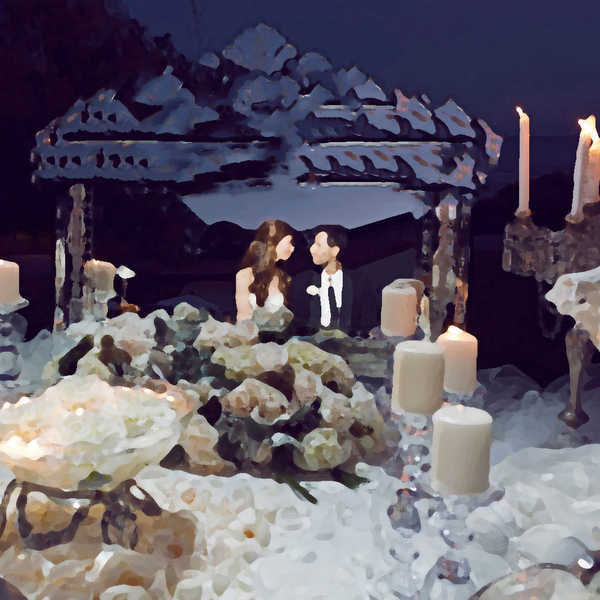
Aroosi: Everything You've Ever Wanted to Know About Persian Weddings
Some big news for Chai and Conversation listeners. This upcoming May 2015, I, Leyla Shams, am going to marry my best friend of 12 years in Austin, Texas. That decision was a no-brainer. The wedding itself, however, is a different story.
My fiancé (nāmzad) and I decided together early on that the wedding (aroosi) would follow Persian customs and traditions (despite being American he really has no choice- he is marrying the creator of Chai and Conversation after all!). Because he’s never been to a Persian wedding, we eagerly looked online together for some resources showing what exactly a Persian wedding looks like. I assumed that with the popularity of Persian weddings, there would surely be a slew of information detailing everything about them. Alas, in this case, the internet came up short. Sure, there are a few articles and Wikipedia entries here or there, but an all inclusive, exhaustive reference for someone who wants to know exactly what they’re getting themselves into when agreeing to a Persian wedding- nothing of the sort.
So, as we always do when we find a lack of resources at Chai and Conversation- we put our research caps on, interviewed friends and family, and came up with the following 3 part guide to Persian weddings.
Please enjoy, and as always, if you notice something we are missing, or would like to share your own experiences with Persian weddings, please leave them in the comment section below.
What is a Persian wedding?
The wedding is one of the most important occasions in the Persian tradition- it is an event in which all are invited, no expenses are spared, and much feasting and merry-making takes place. As Massoume Price beautifully stated:
"For Iranians marriage is an event, which must be celebrated not quietly but with glory and distinction. It is the most conspicuous of all the occasions and is celebrated in the presence of a fairly large assembly."
Incredibly, most of the traditions of Persian weddings originated in Zoroastrian times (Zoroastrianism is an ancient Iranian religion, the first monotheistic religion in the world dating back to the 2nd millennium BCE), and have changed very little up to modern times. This is amazing considering the fact that in that time, not only has technology immensely changed, but empires have come and gone, the Islamic Republic has imposed its own rules on Iranian people, and the Iranian people have dispersed and spread throughout the world. However, despite all that, these traditions are still strong and even thriving to this day. I have noticed throughout the years that even if only one person in a couple getting married is Iranian, chances are extremely high that they will have a wedding with at least some of the traditional Iranian wedding elements. I believe that this is because these traditions are not only highly symbolic and rooted in our psyche, but they are also easily adaptable to our modern times and palatable to western tastes. Fun, joy, and love never fall out of fashion, and these traditions help us to truly achieve these elements of any successful wedding.
So without further ado, let’s go over the elements of a Persian wedding, beginning with the process of asking for a woman’s hand in marriage.
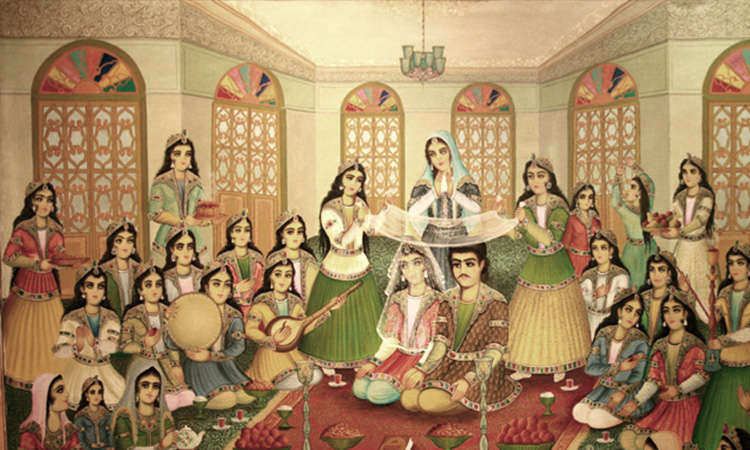
Asking for a woman's hand in marriage
In traditional Iranian families, marriages were more or less arranged by families. When a son became eligible for marriage, his family would take him to the houses of several eligible ladies. In Persian tradition, families are extremely important, so ‘eligibility’ was largely based on the professions, involvement in the community, religious affiliations, wealth, and cultural preferences of both families. After visiting with one or more potential matches, the family of the suitor would then ask the family of a chosen bride for her hand in marriage. This process is called khāstegāree.
In the modern age, this custom is seldom practiced. Iranians, especially in the west, are much more likely to choose a partner using the common courting process of directly dating and making a decision. However, there are some things that may be important to consider when deciding to marry a person of Iranian origin. In most cases, family is still extremely important, and it is considered customary to ask the family for her hand in marriage before proposing. This can be considered the modern day khāstegāree, and is a form of showing respect to long standing Iranian traditions.
So now onto the aroosi itself. As we’ve said, Persian weddings with are very compatible with Western ones, and when executed properly, they can blend seamlessly and enhance one another.
Like most Western weddings, Iranian weddings are broken up into two distinct parts- the aghd (ceremony) and the mehmoonee (reception). Traditionally, Iranian weddings would span several days, with a large amount of time and merry making between the two, but in the modern age when people have become increasingly busier, most weddings now take place over the course of one day.
Aghd
This is the ceremony portion of the wedding. Just as in western weddings, in this portion, the bride (aroos) and groom (dāmād) are situated before the guests, and this is the point at which wedding vows are exchanged and the official marriage contracts are signed. However, there are many customs and rituals observed in the aghd that are very different from Western customs. Because the ceremony itself requires quite an explanation in itself, in this blog post, we will seimply set the physical stage. The aghd requires much preparation and gathering of different elements, which we we will go over now. In the next blog post, we will go over the actual events that take place during the aghd.
Let’s get a general picture of what the wedding ceremony looks like before getting into detail about each element.
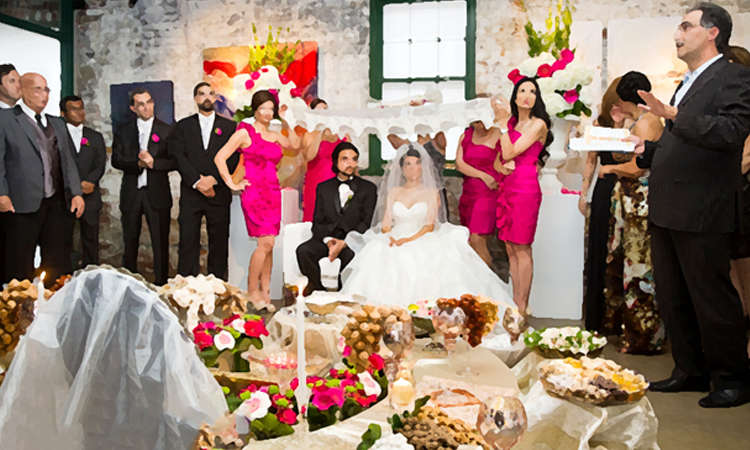
In the aghd portion of the wedding, the ceremony begins with the groom seated on a bench in front of the guests. In front of them is the sofreyé aghd, a table which contains several highly symbolic items. Above his head is a canopy held by female family members or female members of the bridal party. The bride walks into the ceremony wearing a veil. She is preceded by someone burning a special incense called esfand, which is said in Persian tradition to ward off the evil eye. The bride takes a seat to the left of the groom with the groom seated on her right hand- this designates a place of respect.
Now that we have set the general stage of the ceremony, let’s look at each element in detail.
sofreyé aghd
This is perhaps the most important element of a Persian wedding, and what makes it unique from all others in the world. Sofré is the word for tablecloth in Persian. sofreyé aghd is very similar to the sofreh set at nowruz, the Persian new years. Like the one set for nowruz, the sofreyé aghd also directly hails from Zoroastrian tradition, and it has changed very little in the last few thousand years. The tablecloth itself is normally either on the floor on a rug to prevent slippage in an indoor wedding, or constructed on wood raised from the ground about 6-8 inches in an outdoor wedding. It is usually covered by either a simple cloth, or an elaborate cloth called a termé. Usually the bride's mother spends several months before the wedding gathering elements of the sofré- these elements are both objects that are near and dear to the hearts of the bride and groom, and elements that contain imagery and symbolism relating to their impending union. They include the following:
1. ayné va shamdoon (mirror and candlesticks)
This is the most important and most iconic part of the sofré. The mirror and candlesticks will become a part of the couple’s home as a memento of their wedding ceremony, and must therefore be chosen wisely and with the personality of the couple in mind. Traditionally, the mirror and candlesticks were gold dipped or made of silver, but modern couples often opt for other materials. The mirror symbolizes eternity and the candlesticks reference Zoroastrianism, in which light and fire play an extremely important part. In this context, the fire and light represent the brightness of the future and eternal passion. The mirror and candlesticks are situated in front of the bride and groom during the aghd, with the mirror facing the couple and away from the audience. After the bride sits on the stool beside the groom, she lifts her veil, and the groom sees her for the first time in the mirror.
Note: it is customary for the bride and groom to have several photos of them looking into the mirror, again representing them looking into the future.
2. nooné sangak (specially baked flatbread)
nooné sangak is a certain type of flatbread baked in a coal oven on top of coals and stones. On the sofreyé aghd, the bread is usually ornately arranged, either into a shape like flowers, or with the word mobarak (celebrate/congratulations) etched into it. The bread represents prosperity for feasts and the couple’s life thereafter.
In addition to this decorative bread, there is generally a tray of bread, feta cheese, and fresh herbs that are intended to be shared with the guests after the ceremony. This is done to share the couple’s happiness and prosperity with the guests.
3. basket of decorated eggs (tokhmé morgh) and nuts
The sofreyé aghd also includes a basket of decorated eggs- often beaded or painted gold, and various nuts such as almonds, walnuts and hazelnuts, also painted gold. These represent fertility.
 4. bowl made out of crystallized sugar
4. bowl made out of crystallized sugar
The bowl made out of crystallized sugar often also contains more crystallized sugar (also known as rock candy) inside it. This represents sweetness in the couple’s life.
5. bowl of gold coins
These are pretty self explanatory- they represent future financial prosperity for the couple.
6. basket of fruit
A basket of fruit is included- usually either anār (pomegranates) or seeb (apples), depending on the season, to represent a joyous and fruitful future for the couple.
7. tray of spices
This is a well designed part of the table- a tray in which seven spices of seven different colors are laid out in order to represent prosperity and spiciness of life. Each of the spices generally have a specific meaning and significance.
8. esfand
During the ceremony, someone will walk in front of the bride holding an incent called esfand, which will then be placed on top of the sofré. Esfand is a very important element in Iranian tradition, because it has been used for thousands of years to ward away the ‘evil eye’.
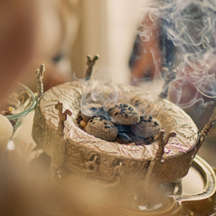
Evil eye is a concept prevalent in the Middle East, and refers to people that look with malignant envy at success. In Iranian tradition, burning esfand prevents the evil eye of people from causing actual harm.
9. canopy
As the bride and groom are seated before the guests, a canopy is held above their heads by several unmarried women, traditionally family members, but in modern weddings, by the bride's wedding party. Until the 19th century, the canopy was green, the favorite color of Zoroastrians, but in recent years, it is a white piece of cloth to blend more with Western culture.
As the ceremony is taking place, happily married members of the family take turns grinding two sugar cones together so that the sugar granules fall into the canopy, symbolically showering the couple in sweetness.
 10. an abundance of flowers
10. an abundance of flowers
Flowers are used in Persian weddings to decorate the sofré, but they are also used as a symbolic sign of life, spring, and beauty.
11. golab (cup of rosewater)
Rosewater is extremely important in Persian culture, and it is used as perfume as well as for cooking. In this case, the rosewater is intended to perfume the air during the ceremony.
12. a book of significance for the couple
For religious couples, the quran is placed on the table, open to a verse about the importance of marriage. Secular couples, on the other hand, will usually display a book of poetry by one of the great Persian poets, or another book that holds a significant place in their relationship.
So this is the stage for the wedding ceremony, or aghd, in Persian tradition.
In the next post in our wedding series, we will look step by step at how the aghd is performed, and then we will explore the party portion- the reception!
Key vocabulary words learned in this post:
- aroosi (wedding)
- khāstegāree (asking for a woman's hand in marriage)
- aroos (bride)
- dāmād (groom)
- aghd (wedding ceremony)
- mehmoonee (wedding reception)
- sofreyé aghd (symbolic table)
- ayné va shamdoon (mirror and candlesticks)
